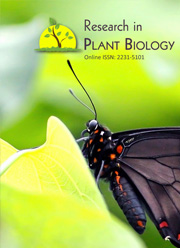Clastogenicity of sugar factory effluent using Allium assay
Abstract
In the current study, an attempt was made to assess the physicochemical parameters of distillery effluent and its cytotoxic effects on root tip cells of onion (Allium cepa L.). The Biochemical Oxygen Demand (BOD), Chemical Oxygen Demand (COD) and Total Dissolved Solids (TDS) were found to be very high in the effluent. The onion bulbs were treated with different concentrations of the distillery effluent (25, 50, 75 and 100%) at room temperature. The percentage mitotic index and relative division rate were found to be decreased significantly as the concentration of the effluent increased. On the other hand, mitotic inhibition percentage and relative abnormality rate were found to increase as the effluent concentration increased. The chromosomal abnormalities were found to be increased as the concentration of the effluent increased when compared to the control. The observed chromosomal abnormalities include sticky metaphase, disturbed chromosome, sticky telophase, multipolar chromosome, laggards, fragmented metaphase, fragmented anaphase, scattered anaphase and chromosomal bridge. From the present study, it can be concluded that higher concentrations of the effluent inhibit cell division when compared to the control.Â
Downloads
References
American Public Health Association, APHA. 2005. Standard Methods for the Examination of Water and Wastewater. 21st ed. American Public Health Association, Washington DC, 1220p.
Chidambaram A, Sundaramoorthy P, Murugan A, Ganesh SK, Baskaran L. 2009. Chromium induced cytotoxicity in Black gram (Vigna mungo L.), Ind. J. Environ. Health. Sci. Eng. 6 (1), 17-22.
Fayaza A, Nasr, Hala M, El-Kamah. 1996. Chemico-Biological treatment of dairy waste water. Environmental Management and Health, 7(3), 22-27.
Fiskesjo G. 1985. The Allium test as a standard in environmental monitoring. Hereditas 102: 99–112.
Grant WF. 1978. Chromosome aberration in plants as monitoring system. Environ. Health Perspective 27: 37-43.
Jayaprakash CH, Srinivas N, Rao BV, Rao PV. 1994. Effect of chromium (VI) on the mitotic activity of Allium cepa root meristems. J. Environ. Biol. 15(4): 255-261
Khanna N, Sharma S. 2013. Allium Cepa Root Chromosomal Aberration Assay: Indian J. Pharm. Biol. 1(3), 105-119.
Majer BJ, Grummt T, Uhi M, Knasmuller S. 2005. Use of plant assays for the detection of genotoxins in the aquatic environment. Act of Hydrochemistry and Hydrobiology 33: 45-55.
Om HN, Singh, Arya MS. 1994. Combined effect of wastes of distillery and sugar mill on seed germination, seedling growth and biomass of okra (Abelmoschus esculentus L. Moench). J. Environ. Biol. 15, 171-175
Pickett-Heaps JD, Trimothy. 1982. Studies on the kinetochore function in mitosis effect of colchicines and cytochalasin on mitosis in the diatom Hantzschia amphioxys. Eur. J. Cell Biol. 28(1), 77-82.
Pulate PV, Tarar JL. 2014. Cytogenetic effects of tilt on root tip meristem of Onion (Allium cepa L.) Int. J. Plant Animal and Envt. Sci. 4(2), 53-57.
Rekha K, Kak SN, Langer A. 2004. Cytological abnormalities in Artemisia pollens Wall. Induced by gamma rays. Ind. J. Fores. 27, 355 – 359.
Saranraj P, Stella D. 2014. Composting of sugar mill waste: A review. World App. Sci. J. 31(12), 2029-2044.
Shanthamurthy KB, Rangaswamy V. 1979. Cytological Effects of Paper Mills Effluents on Somatic Cells of Allium cepa. Cytologia 44, 921 -926
Srivastava S, Jain R. 2010. Effect of distillery spent wash on cytomorphological behaviour of sugarcane settlings. J. Environ. Biol. 31(5), 809-812.
United States Environmental Protection Agency (USEPA). 1996. Acid digestion of sediments, sludge’s and soil method - 3050B. USEPA, Washington, DC.
Yuzbasioglu D, Unal F, Sancak C, Kasai R. 2003. Cytological effects of the herbicide racer “flurochloridone†on Allium cepa L. Caryologia 56(1), 97-105.



 .
. 